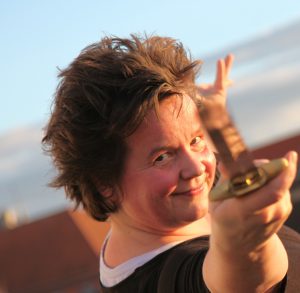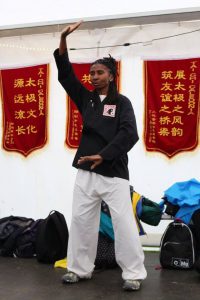From Monday 9th - Thursday 12th July you can train for 21/2 hours each morning and afternoon, over the four days, allowing 10 hours intensive training, each morning and afternoon, working on 2 separate disciplines (1 each from A and B) for 5 hours per day in total. These choices are divided into sections - A & B, please select one from each category.
 Baguazhang for sceptics and future lovers! – Angela Menzel (A1)
Baguazhang for sceptics and future lovers! – Angela Menzel (A1)
Besides being a Chinese martial art belonging to the NeiJia family, Baguazhang is a lot of fun and its learning process is very different from Taiji Quan! What you will learn during this workshop is a small, handy and natty Bagua form which works on a line as well as on the circle. It consists of 4 movements done to both sides. It is also easily put together in a partner form. We will properly practise basics as they make Bagua flow and whirl and if you want more I have another short and handy form in stock for you! Either way it will influence your skills in a way you can sustain! For those of you who are already hot for Bagua you can have a really intensive week by combining my offering with that of Luigi Zanini!!! Accessible to all.

Luohan Qigong – Yonghui Deistler-Yi (A2)
This form of Qigong originates form the Shaolin Temple and is named after the 18 legendary guards of Buddhism. The exercises strengthen the muscles, bones and sinews – the whole body is filled with Qi. At later states your body structure and the flow of refined power (Jin) will be improved and even the bone marrow is targeted (Xi Sui Jing).
These exercises bring great benefits for both, health and any martial art.
Accessible to all.

On Dealing With an Opponent: 37 Essential Forms of Yang Chengfu – Sam Masich (A3)
In his 1931 book, ‘Taijiquan Method and Application’ Master Yang Chengfu (1883-1936) described 37 core forms essential to the understanding of martial application. After listing all the forms within the long form he states, “The full sequence is composed entirely of thirty-seven distinct forms.” Sam Masich’s extensive work in this area has stimulated breakthroughs in the theory of taijiquan. His principled approach breaks the 37 forms into 13 ‘families’ allowing for a deeper understanding of taiji’s underlaying structure. Accessible to all.

Tuina Basic Techniques – Roberto Benetti (A4)
Tuina is a perfect complement to those who train in Martial Arts or have an interest in massage. We will study basic principles and key techniques with an emphasis on developing internal work and Qigong to prepare the body and mind. We will develop sensitivity through the correct practice of Tuina and its application in Push Hands.
For beginners and those interested in deepening their martial practice as well as for practitioners of other Internal or Healing Arts.

The Eight Gates of the Taiji Sword – Yanira Masich (B1)
Graceful and profound, taiji straight-sword (taijijian) is the most popular of the weapons in taijiquan curriculum. The main focus of this week will be the ‘eight-gates’ sword energies and drills that comprise a major part of the taiji thirteen-power sword. The practical simplicity of the eight-gates study brings the sword to life, enlivening solo forms and partner practices.
Some previous experience of sword work would be advantageous but not necessary.

Developing Awareness & Connection in our Practice
– Gillian Reid (B2)
In every martial art or walk of life, Man must connect in order to be, and interact. We will be working with the qualities of energy that make up our micro and macro cosmos and how, through awareness, we can improve the efficiency of our personal practice and walk of life.
Accessible to all.

Rushou and Ganshou – Luigi Zanini (B3)
A requisite to develop skills in a martial art is regular and deep practice of two person work. Only by putting theory into a real context do we discover the subtle skills we need to apply. Energies involved are similar to those of Taijiquan, such as Nien, Ting, Peng, Lu, but they are developed using a higher degree of torsions and circles, since this extra power is very useful and invested in Baguazhang. Hands can be very soft, but also quite hard at times during longer sessions. The goal is to be able to “kill the Ego” in order to achieve new abilities and change the way our mind-body reacts.
Open to all levels, an open attitude is strongly recommended.

Shibashi, Set 8 – Helmut Oberlack (B4)
Shibashi, also known as 18 Movements Taiji-Qigong is a very popular Qigong-exercise. It has different sets with 18 movements, most common are set 1 and set 2. Set 3 was introduced to Tai Chi Caledonia 2015. This time Helmut will introduce set 8, a kind of “Best of“ the other sets. It has also 18 movements, but each movement contains two movements from the other sets. So it has 36 movements in total.
It is recommended, but not necessary, to know other sets of Shibashi.
Copyright 2025 Tai Chi Caledonia | Privacy Policy